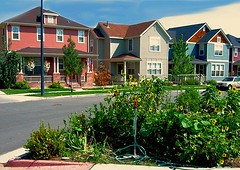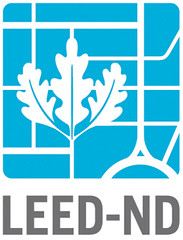LEED for Neighborhood Development formally launches to promote smart, sustainable land use

Posted April 29, 2010 at 1:34PM
The country’s first comprehensive system for defining, measuring, and certifying smart growth is now fully open for business.
Today, the three founding partners of LEED for Neighborhood Development – NRDC, the Congress for the New Urbanism, and the US Green Building Council – are announcing the national launch of the program at simultaneous events in metropolitan Washington, DC and Chicago. We are being joined by the US Environmental Protection Agency, LEED-ND’s first financial supporter, and Smart Growth America, NRDC’s coalition partner and longtime collaborator.
 Previously, LEED-ND had been operating only as a pilot program, and was not accepting new registrations of projects for evaluation and certification. Over 200 projects across the country and internationally have been participating in the pilot, and 68 had been certified as of March 1.
Previously, LEED-ND had been operating only as a pilot program, and was not accepting new registrations of projects for evaluation and certification. Over 200 projects across the country and internationally have been participating in the pilot, and 68 had been certified as of March 1.
In our press release and at the DC-area event, I emphasize that fifty percent of the buildings we will have on the ground in 25 years have not yet been built, providing us with both a major challenge to sustainability and a major opportunity to get it right for both people and the environment. We also know from research that where we build is even more important to the environment than what we build.
It is my view that, while we in the environmental movement have always been good at identifying problems – including the havoc wreaked by sprawl – we have not always been equally adept at identifying pragmatic solutions. For land use, LEED-ND is a major step forward in closing that gap, articulating the kind of development that reduces global warming emissions, land consumption, traffic, resource waste and pollution while enhancing livability. The system is built around three major categories of standards: regional location and linkages, neighborhood pattern and design, and green infrastructure and buildings.
 It is emblematic of our goals that, for the DC area event, we are announcing the launch of the system at Twinbrook Station, a gold-certified, smart, walkable development (in progress) being built around a Metro rail transit station in the midst of what has long been some of our region’s worst sprawl, the notorious Rockville Pike corridor in suburban Maryland, northwest of Washington. (The Chicago event is being held at Block 37, a mixed-use project under construction in Chicago’s downtown.)
It is emblematic of our goals that, for the DC area event, we are announcing the launch of the system at Twinbrook Station, a gold-certified, smart, walkable development (in progress) being built around a Metro rail transit station in the midst of what has long been some of our region’s worst sprawl, the notorious Rockville Pike corridor in suburban Maryland, northwest of Washington. (The Chicago event is being held at Block 37, a mixed-use project under construction in Chicago’s downtown.)
My friend John Norquist, president and CEO of CNU, says in our joint release, “LEED for Neighborhood Development contains the components for compact and complete neighborhoods. With walkable streets, appropriately-scaled schools, and a mix of amenities close by, residents can lower their environmental impact while improving their quality of life.”
LEED-ND has progressed from being just an idea in 2002 to becoming a concept, a draft set of standards, more drafts (I lost count of how many), a pilot program, and now a full-scale program in 2010. It is not perfect – how could it be? – but it is designed to be updated and improved as we gain experience. We learned a lot in the pilot program, and the fully revised standards are, in my opinion, much better. To say that a lot of hard work on the part of staff and volunteers went into making it all happen would be a serious understatement.
 “Sustainable communities are prosperous communities for the occupants and businesses that inhabit them,” according to Rick Fedrizzi, President, CEO & Founding Chair of the US Green Building Council. “LEED for Neighborhood Development projects are strategically located in or surrounding metropolitan areas – often times revitalizing brownfields, infill or other underutilized spaces, opening new revenue streams, creating jobs opportunities and helping to drive the local, state and national economies.”
“Sustainable communities are prosperous communities for the occupants and businesses that inhabit them,” according to Rick Fedrizzi, President, CEO & Founding Chair of the US Green Building Council. “LEED for Neighborhood Development projects are strategically located in or surrounding metropolitan areas – often times revitalizing brownfields, infill or other underutilized spaces, opening new revenue streams, creating jobs opportunities and helping to drive the local, state and national economies.”
Thank you, John, and thank you, Rick. I can’t possibly mention everyone who deserves a pat on the back for this, and they are all friends at this point, so I really don’t want to leave anyone out. You know who you are.
Our hope is that LEED-ND will prove to be an asset for development projects that meet the standards, separating the worthy from the pretenders and giving the worthy a stamp of approval that can help their case as they make their way through the local entitlement process. We also hope it will help local environmentalists and citizens’ groups evaluate development proposals, and that it will provide templates for governments at all levels to borrow from as they upgrade their policies to support sustainable, green neighborhoods.
You can get an overview and updates on the site of the US Green Building Council, where you can also download the system's standards.